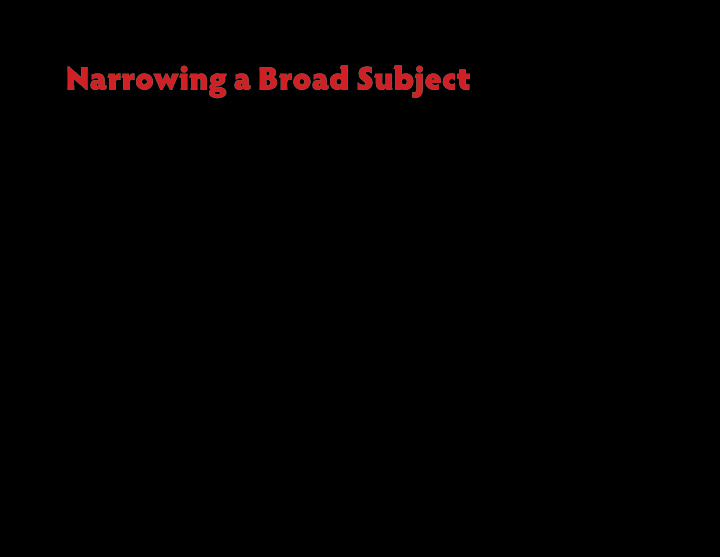



Narrowing a Broad Subject 04.14.13 || English 1301: Composition I || D. Glen Smith, instructor
From Broad Topic to Narrow Subject Step One: Find a Subject: Through a listing technique the writer breaks down the broad topic to a manageable size and likewise fjnds a working subject of interest to use for a paper. • For example, the topic “music” is too broad of term for a fjve page paper. It is likewise too vague for informal research. Music > Latin Music > Latin Jazz > Latin Dance > Salsa > Salsa’s Development in Puerto Rico > Salsa’s Development in Puerto Rico during the 1970’s 2 04.14.13 || English 1301: Composition I || D. Glen Smith, instructor
From Broad Topic to Narrow Subject Step Two: Conduct Preliminary Research: The fjrst stages of research enables a writer to discover what he/she already knows, and what he/she does not know. In addition, keywords can be collected and used for a more extensive, formal research process. • For example, the topic “music” is too broad of term for a fjve page paper. • It is likewise too vague for informal research. KEY WORDS: (These words came from another listing session and from readings in an encyclopedia, CD linear notes, and the Rolling Stone Magazine.) Salsa, history, music, Puerto Rico, culture, Tito Puente, Celia Cruz, Hector Lavoe, Cuba, Latin Jazz, dance, New York City 3 04.14.13 || English 1301: Composition I || D. Glen Smith, instructor
From Broad Topic to Narrow Subject Step Three: Map out an Introduction: Using an informal outline process, a writer can examine possible introductory material for the work. Preliminary Outline for fjrst Paragraph: Mapping Out an Idea I. Music defjnes the human experience. ( overview / generalization ) A. No matter the culture, music offers sense of history, identity B. Development of a people, race C. Diverse cultures, diverse music D. Types of Latina Musica as example, regionalized music E. Salsa in particular very popular F. Salsa developed in Puerto Rico and US in 1970’s > why/ how? 4 04.14.13 || English 1301: Composition I || D. Glen Smith, instructor
From Broad Topic to Narrow Subject • Notice how some key words appear in the outline; it is important that your opening paragraph should include research elements or defjnitions which relate specifjcally to your topic. • The outline also illustrates the actual process of moving from a broad subject to a limited subject. • Using an informal outline process, a writer can examine possible introductory material for the work. 5 04.14.13 || English 1301: Composition I || D. Glen Smith, instructor
From Broad Topic to Narrow Subject Preliminary Outline I. Music defjnes the human experience. ( broad topic ) A. No matter the culture, music offers sense of history, identity B. Development of a people, race C. Diverse cultures, diverse music D. Types of Latina Musica as example, regionalized music E. Salsa in particular F. Salsa developed in Puerto Rico and US in 1970’s ( limited, specifjc subject ) 6 04.14.13 || English 1301: Composition I || D. Glen Smith, instructor
From Broad Topic to Narrow Subject Step Four: Answer Lingering Questions: In this particular case, the last item in the outline results in a ‘why’ or ‘how’ question. • Answering this will end up strengthening the direction of the writer’s paper and result in a full thesis statement. Salsa music rose to popularity in N.Y.C. during the 1970’s because it offered a strong sense defjnition of the Hispanic experience to Latino residents . 7 04.14.13 || English 1301: Composition I || D. Glen Smith, instructor
From Broad Topic to Narrow Subject Step Five: Rewrite: Finally, the thesis is shaped according to the content displayed in the introduction paragraph. Music defjnes the human experience. No matter the culture, music offers the listener a sense of history and identity. It shows the development of a race of people through the diversity of the people. Latin Music itself displays a wide collection of different styles and rhythms. Each style comes from a different region of the Caribbean or Latin America. In particular, Salsa has a rich history of regional infmuences. Since its early beginnings in the 1970’s, Salsa remains a popular music choice today, even in the U.S., because it offers a strong sense of defjnition for the Hispanic experience for Latino residents. 8 04.14.13 || English 1301: Composition I || D. Glen Smith, instructor
Recommend
More recommend